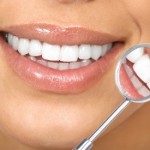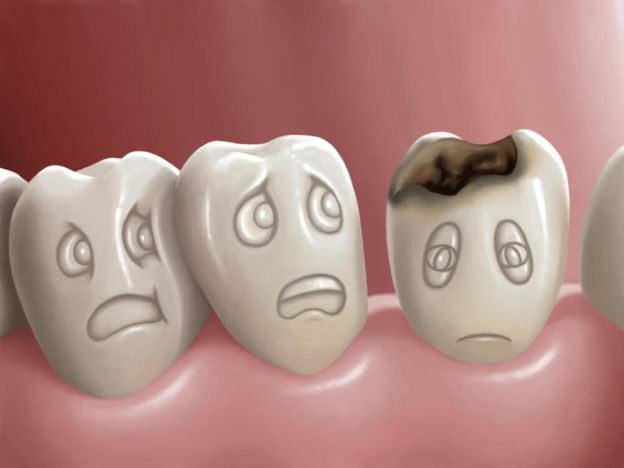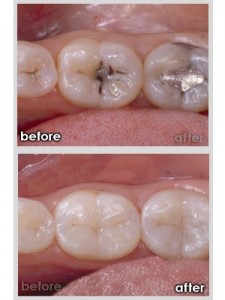What are Cavities and Tooth Decay?
Tooth decay is the most prevalent disease for children and adults in the United States, even though it is mostly preventable. Tooth decay occurs as bacteria attaches to the tooth via dental plaque or tartar and feeds off the sugars and fermentable carbohydrates consumed by their host.
Bacteria secrete acidic byproducts break down tooth structure and lower the pH in the mouth, which then activates more harmful bacteria, causing more acid secretion and subsequent breakdown of tooth structure. In response to frequent acid exposure, the outer surface of the tooth loses minerals. This process of losing minerals is tooth decay. If left unchecked, this process can advance to the inner surface of the tooth causing more damage and pain.
Factors of Tooth Decay
There are multiple factors that contribute to tooth decay:
- Namely genetics (in the structure and formation of your tooth)
- Types of bacteria that form the normal flora of your mouth
- Diet – the frequency of exposures to sugars and fermentable carbohydrates (food source for the bacteria)
- Frequency and quality of oral hygiene
- Reintroduction and bioavailability of minerals to remineralize damaged tooth structure
- Frequency and quality of professional dental services rendered or available.
How Decay is Found & Removed
Tooth decay can be found radiographically or clinically during a dental examination. Some decay is minimal and can be remineralized, reversing the harmful process. Other decay is advanced and needs to be surgically removed by the dentist. After decay is removed, the missing tooth structure is replaced with dental filling. Our office uses resin, tooth-colored fillings that are bonded securely in place. Our office only uses products that are rated the highest in safety and efficacy. A well-placed filling can feel, function, and look very nice.
How to Prevent Tooth Decay
Tooth decay may be prevented by modifying diet, hygiene, and remineralization. Being careful with your diet can limit tooth decay. Exposure to sugar and carbohydrates is the most common cause of tooth decay – the amount of the exposure, the nature of the substance, and its pH also factor in.
A Word on Your Diet
It isn’t bad to have a snack or a treat, but the amount of exposures should be limited. Here are a couple tips to help you have stronger, healthier teeth:
- Eating a couple candies every twenty minutes throughout the afternoon can be a lot of exposure and keep your mouth acidic, allowing the bacteria to work constantly against you. It is the same with soda. Soda drinking should be limited, sipping on a soda or juice throughout the day keeps the mouth acidic and activates the bacteria.
- Limit your sugar and carb intake, particularly between mealtimes.
- Avoid snacks that are sugary, chewy, or dissolve slowly, as these are more retentive in your mouth causing problems for a longer amount of time. Examples are caramels, taffies, and suck-on candies.
- Avoid foods and drinks that are acidic, particularly between mealtimes, such as some fruit juices, sodas, sports drinks, sour candies, and yogurts.
Important: Clean Your Teeth Regularly
 The amount of time and effort you spend cleaning your teeth can make a big difference in preventing tooth decay. Remove plaque buildup and bacteria by brushing at least twice, flossing at least once, and using a mouth rinse at least once a day. Some decay can also be remineralized by adding bioavailable minerals such as calcium or fluoride into your hygiene regimen. These minerals can be found in certain foods, toothpastes, and mouthwashes.
The amount of time and effort you spend cleaning your teeth can make a big difference in preventing tooth decay. Remove plaque buildup and bacteria by brushing at least twice, flossing at least once, and using a mouth rinse at least once a day. Some decay can also be remineralized by adding bioavailable minerals such as calcium or fluoride into your hygiene regimen. These minerals can be found in certain foods, toothpastes, and mouthwashes.
Regular dental checkups can help prevent decay, or detect decay at early easily treatable stages. If you’re due for a dental examination, or desire more information on preventing tooth decay, please give us a call at (208) 524-1700.













